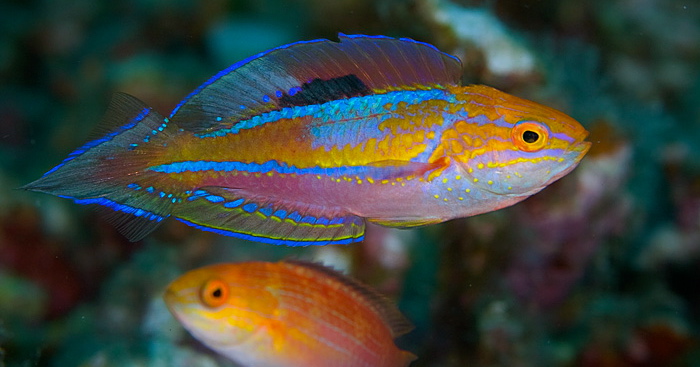Cirrhilabrus isosceles is the 51st member of the fairy wrasse genus, and one whose time to receive official scientific description has been long overdue. Long referred to as C. cf lanceolatus or the Pintail Fairy Wrasse, this is a fish that packs an insane amount of color into a slightly smaller body for a fairy wrasse.
It is unclear why this fish took so long to receive a formal description, but it feels like now that Cirrhilabrus isosceles is officially a new species, we can celebrate the long road it took to arrive at ‘species-hood’. The newly minted Pintail Fairy Wrasse holds a very special place in our reefing and blogging hearts, as it was one of the first exciting rare fish that we wrote about in the pages of Reef Builders.

As far back as 2009 Cirrhilabrus isosceles was making a limited appearance at rare fish specialty stores with a then princely sum of $1000 a piece! After a long hiatus from the hobby, the pintail fairy wrasse resurfaced in recent years with increased collections in Northern Philippines and it now is readily available for about the same cost as most reasonably showy fairy wrasse species.
With increased availability of live specimens, the impetus for describing this species was renewed. Veteran Reef Builders exotic fish editor Lemon TYK moved on to bigger and better things, the beginning of his formal ichthyological studies at the University of Sydney with dottyback expert, Dr. Anthony Gill. Together with Brian Greene and Hiroshi Senou, Lemon scored the ultimate ichthyology rookie card by describing such an illustrious fish as the Pintail Fairy Wrasse.

Cirrhilabrus isosceles is described from six specimens collected from Southern Japan and Northern Philippines in the Northwest Pacific Ocean, and it is also known to occur in Taiwan. In this region it is found at relatively deep water of 30 to 36 meters, or 98 to 118 feet deep, on typical fairy wrasse habitat of open flat and sloping bottoms, with scattered outcrops of rock and corals.
Despite its spade-shaped pintail, Cirrhilabrus isosceles is not closely related to the other two species with similar tail shapes, Cirrhilabrus lanceolatus and Cirrhilabrus roseofascia. Instead the pintail fairy wrasse is more closely related to Cirrhilabrus brunneus, C. lunatus and C. squirei which was first proposed in our review of the Lunatus group of fairy wrasses, and confirmed by genetic analysis. [JOSF]




